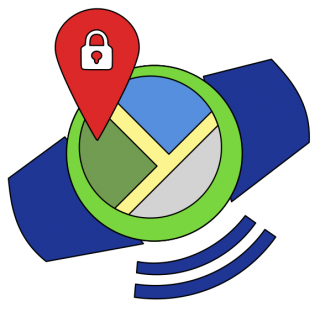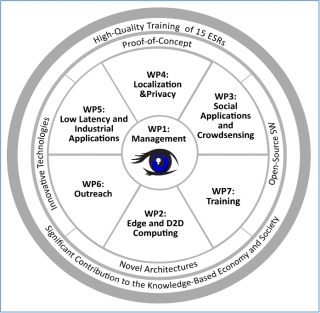Background
A-WEAR is a four year (2019-2022) H2020 Marie Sklodowska-Curie Innovative Training Network (ITN)/European Joint Doctorate (EJD) 4 bringing together five beneficiaries and 12 partner organizations from Finland, Czech Republic, Italy, Romania, and Spain, with the aim of educating, supervising, and training 15 young ambitious and creative researchers to face the future challenges in smart wearables and wireless computing and enhance their career prospects by training them in a multi-sector cross-country environment and teaching them to think globally.
The emerging market of wearables is expected to grow exponentially in the near future, driven by the sales increase of smart clothes, watches, and eyeglasses. The future wearables are likely to be heterogeneous, operating on batteries, sun power or human motion, and endowed with smart functions. They will co-operate in a decentralized manner with each other and will be able to reach various interconnected software and applications. The main stream wearable-based architecture has been applied so far in wellbeing industries, such as eHealth or ambient assisted living, which might also reduce the costs for care and guarantee a healthy independent live in the forthcoming older society. As the digitalisation and data-based economy are growing, the exploitation potential of the wearables can easily be expected to increase. Key wearables stakeholder groups in the future are also smart cities, comprising intelligent building industry and infrastructure, energy-efficient smart grid sector, public e-Services, and smart transport. Motivated by the opportunities that next-generation wearable intelligence is expected to provide, the mission of A-WEAR action is to cross-disciplinarily create new architectures, open-source software and frameworks for dynamic wearable ecosystems, with distributed localization and privacy constraints. We aim at building new joint/double European doctoral programmes to train a new generation of young researchers in order to be aware of, to cope with, and to disseminate to a large audience the vulnerabilities and the corresponding solutions of the communication and positioning through wearables. The impact of A-WEAR will be to enhance the future social well-being, to contribute to an easy living, effective and enjoyable work, and to offer new solutions to the challenges of violation of privacy by communication and positioning through wearables and to the need of applying the right of the ownership to one’s data.
Goal
Aim to train a new generation of creative, entrepreneurial and innovative early-stage researchers, able to face current and future challenges and to convert knowledge and ideas into products and services for economic and social benefit.
Funding
The work described in this website is conducted within the project A-WEAR. This project has received funding from the European Union’s Horizon 2020 (H2020) Marie Sklodowska-Curie Innovative Training Networks H2020-MSCA-ITN-2018 call, under the Grant Agreement no 813278. This website and the content displayed in it do not represent the opinion of the European Union, and the European Union is not responsible for any use that might be made of its content.
Work Package Structure
WP1 – Management.
Objectives:
- Ensure internal and external communication, technical coordination as well as the legal and administrative functioning of the network;
- Implement timely financial and scientific reporting;
- Promote the diversity, equality and gender balance;
- Ensure the risk, IPR and quality management;
- Ensure a unified, fair and equal opportunity recruitment strategy;
- Setting up sustainable double/joint PhD agreements
WP2 – Edge and D2D computing.
Objectives:
- To provide novel edge/fog and device-to-device (D2D) computing architectures for increased energy efficiency and decreased latency in wearable D2D applications;
- To introduce scalable wearable architectures combining edge/fog with cloud computing and allowing the delegation of use;
- To develop efficient and low-energy consumption methods for digital wireless communication of massive wearable networks;
- To study the best multi-connectivity options in the context of highly dynamic heterogeneous wearables networks
WP3 – Social applications and crowdsensing
Objectives:
- To create open-source software and apps for wearables used for social well-being, such as eHealth and for services relying on massive crowdsensed data;
- To identify potential eHealth applications and services that might be fed by crowdsensed data;
- To develop efficient methods for gathering and store data from crowd sensing;
- To study the potential benefits of applications for social well-being and innovative eHealth architectures;
- To develop advanced algorithms for decision making and data extracting in the eHealth applications
WP4 – Localization and privacy
Objectives:
- To build a proof of concept of a privacy-aware seamless and accurate localization engine with dynamic nodes and wearables relying on a mesh architecture;
- To develop low-cost hybrid positioning techniques for cm-level accuracy;
- To develop novel cryptographic technologies for the protection of privacy and digital identity of users carrying wearables;
- To create an Urban Mobility Observatory, which provides the necessary infrastructure and tools for individuals to store, access, analyse and visualise their mobility data, in a secure and privacy-preserving fashion.
WP5 – Low-latency and industrial applications
Objectives:
- Develop new low-latency approaches for wearable architectures;
- Create innovative techniques and technologies for improved safety via wearables in industrial applications;
- Investigate the use of AI and machine learning techniques for miscellaneous signals processing in wearable
applications


